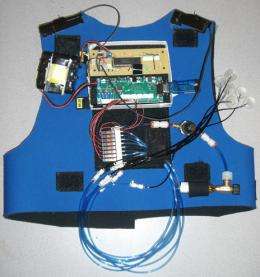April 6, 2010 report
Vest to prevent balance disorder patients falling

(PhysOrg.com) -- A vest being developed by scientists at the University of California, Los Angeles (UCLA) could help people with balance disorders to regain their balance. This could cut short the rehabilitation or balance retraining exercise period, reduce the risk of falling, and improve patients' quality of life.
Balance disorders can make you feel dizzy or unsteady, or feel as if you are spinning, falling, or moving when you are not. They can be caused by brain injuries, infections, some medications, or problems with the vestibular system in the inner ear, and can cause a wide range of symptoms including falls, staggering, lightheadedness, blurred vision and disorientation.
Developed by researchers at UCLA’s Center for Advanced Surgical and Interventional Technology (CASIT), the vest is portable and self-contained, and measures the rotation and tilting of the patient’s body during walking. Wobbling is detected by a series of accelerometers across the shoulders, and if any is found silicone balloons attached to the vest are inflated to give the wearer a physical indication of the imbalance. Pairs of balloons are located above the rib cage, between the shoulder blades, and above the trapezius muscles on the left and right mid-shoulders.
The tactile vest system includes an electronic control system providing virtually instantaneous feedback, and patented pneumatic actuators and an air tank. Similar vests have been developed in the past for flight simulators or games, but not for rehabilitation for balance disorders.
One of the project leaders, Martin Culjat, said the balloon actuator has a special membrane that enables the pneumatic balloon to be inflated at a high enough pressure that the vest wearer will feel it pushing against the skin. One of the advantages of pneumatic actuators is that they have a faster reaction time (60 ms) than other types of actuators, enabling real-time feedback for the patients. Other types of actuators also have a disadvantage because they can send vibrotactile signals to the body, to which the person can become less sensitive over time.
The group’s findings were presented at the 2010 Haptics Symposium last month in Waltham, Massachussetts. Haptic technologies are those that use tactile sensations and controls to interact with computer applications, and they are commonly used for applications such as training for tasks needing hand/eye coordination, or for games in which you see and feel your interactions with images.
© 2010 PhysOrg.com


















